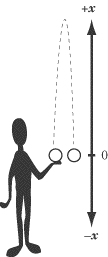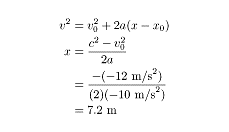Lesson: Chapter - 5
One-Dimensional Motion with Uniform Acceleration
Many introductory physics problems can be simplified to the special
case of uniform motion in one dimension with constant acceleration.
That is, most problems will involve objects moving in a straight line
whose acceleration doesn’t change over time. For such problems, there
are five variables that are potentially relevant: the object’s position, x;
the object’s initial velocity,v0 ; the object’s final velocity, v; the object’s
acceleration, a; and the elapsed time, t. If you know any three of these variables,
you can solve for a fourth. Here are the five kinematic equations that you should
memorize and hold dear to your heart:

The variable x0 represents the object’s position at t = 0. Usually, x0 = 0.
You’ll notice there are five equations, each of which contain four of the
five variables we mentioned above. In the first equation, a is missing; in the second,
x is missing; in the third, v is missing; in the fourth,v0 is missing; and in the fifth, t is
missing. You’ll find that in any kinematics problem, you will know three of the five variables,
you’ll have to solve for a fourth, and the fifth will play no role in the problem. That means
you’ll have to choose the equation that doesn’t contain the variable that is irrelavent to
the problem.
Learning to Read Verbal Clues
Problems will often give you variables like t or x,
and then give you verbal clues regarding velocity and acceleration.
You have to learn to translate such phrases into kinematics-equation-speak:
|
When They Say . . . |
They Mean . . . |
|
“. . . starts from rest . . .” |
v0 = 0 |
|
“. . . moves at a constant velocity . . .” |
a = 0 |
|
“. . . comes to rest . . . ” |
v = 0 |
Very often, problems in kinematics on subject test Physics will involve a
body falling under the influence of gravity. You’ll find people throwing
balls over their heads, at targets, and even off the Leaning Tower of Pisa.
Gravitational motion is uniformly accelerated motion: the only acceleration
involved is the constant pull of gravity, –9.8 m/s2 toward the center of the
Earth. When dealing with this constant, called g, it is often convenient to
round it off to –10 m/s2.
Example

A student throws a ball up in the air with an initial velocity of 12 m/s
and then catches it as it comes back down to him. What is the ball’s velocity
when he catches it? How high does the ball travel? How long does it take the
ball to reach its highest point?
Before we start writing down equations and plugging in numbers, we need to
choose a coordinate system. This is usually not difficult, but it is vitally important.
Let’s make the origin of the system the point where the ball is released from the student’s
hand and begins its upward journey, and take the up direction to be positive and the down
direction to be negative.
We could have chosen other coordinate systems—for instance,
we could have made the origin the ground on which the student is standing—but our
choice of coordinate system is convenient because in it, x0 = 0, so we won’t have to worry
about plugging a value for x0 into our equation. It’s usually possible, and a good idea,
to choose a coordinate system that eliminates x0 . Choosing the up direction as
positive is simply more intuitive, and thus less likely to lead us astray.
It’s generally wise also to choose your coordinate system so that more variables
will be positive numbers than negative ones, simply because positive numbers
are easier to deal with.
What is the ball’s velocity when he catches it?
We can determine the answer to this question without any math at all.
We know the initial velocity,v0 = 12 m/s, and the acceleration due to gravity, a = -10 m/s2,
and we know that the displacement is x = 0 since the ball’s final position is
back in the student’s hand where it started. We need to know the ball’s final
velocity, v, so we should look at the kinematic equation that leaves out time, t:

Because both x and x0 are zero, the equation comes out to
 But don’t be hasty and
give the answer as 12 m/s: remember that we devised our coordinate system in such a way
that the down direction is negative, so the ball’s final velocity is –12 m/s.
But don’t be hasty and
give the answer as 12 m/s: remember that we devised our coordinate system in such a way
that the down direction is negative, so the ball’s final velocity is –12 m/s.
How high does the ball travel?
We know that at the top of the ball’s trajectory its velocity is zero. That means that
we know that ,v0 = 12 m/s, v = 0, and a -10 m/s2, and we need to solve for x:

How long does it take the ball to reach its highest point?
Having solved for x at the highest point in the trajectory,
we now know all four of the other variables related to this point,
and can choose any one of the five equations to solve for t. Let’s
choose the one that leaves out x:

Note that there are certain convenient points in the ball’s trajectory
where we can extract a third variable that isn’t mentioned explicitly in the question:
we know that x = 0 when the ball is at the level of the student’s hand, and we know that
v = 0 at the top of the ball’s trajectory.
Back
Next
v>
Next to display next topic in the chapter.
Practice Questions
Video Lessons and 10 Fully Explained Grand Tests
Large number of solved practice MCQ with explanations. Video Lessons and 10 Fully explained Grand/Full Tests.